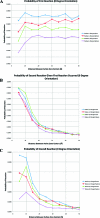Channeling by Proximity: The Catalytic Advantages of Active Site Colocalization Using Brownian Dynamics
- PMID: 20454551
- PMCID: PMC2865391
- DOI: 10.1021/jz1002007
Channeling by Proximity: The Catalytic Advantages of Active Site Colocalization Using Brownian Dynamics
Abstract
Nature often colocalizes successive steps in a metabolic pathway. Such organization is predicted to increase the effective concentration of pathway intermediates near their recipient active sites and to enhance catalytic efficiency. Here, the pathway of a two-step reaction is modeled using a simple spherical approximation for the enzymes and substrate particles. Brownian dynamics are used to simulate the trajectory of a substrate particle as it diffuses between the active site zones of two different enzyme spheres. The results approximate distances for the most effective reaction pathways, indicating that the most effective reaction pathway is one in which the active sites are closely aligned. However, when the active sites are too close, the ability of the substrate to react with the first enzyme was hindered, suggesting that even the most efficient orientations can be improved for a system that is allowed to rotate or change orientation to optimize the likelihood of reaction at both sites.
Figures



Similar articles
-
Molecular mechanics studies of factors affecting overall rate in cascade reactions: Multi-enzyme colocalization and environment.Protein Sci. 2024 Oct;33(10):e5175. doi: 10.1002/pro.5175. Protein Sci. 2024. PMID: 39276014 Free PMC article.
-
Brownian dynamic study of an enzyme metabolon in the TCA cycle: Substrate kinetics and channeling.Protein Sci. 2018 Feb;27(2):463-471. doi: 10.1002/pro.3338. Epub 2017 Nov 21. Protein Sci. 2018. PMID: 29094409 Free PMC article.
-
Diffusional channeling in the sulfate-activating complex: combined continuum modeling and coarse-grained brownian dynamics studies.Biophys J. 2008 Nov 15;95(10):4659-67. doi: 10.1529/biophysj.108.140038. Epub 2008 Aug 8. Biophys J. 2008. PMID: 18689458 Free PMC article.
-
Design and biocatalytic applications of genetically fused multifunctional enzymes.Biotechnol Adv. 2022 Nov;60:108016. doi: 10.1016/j.biotechadv.2022.108016. Epub 2022 Jul 1. Biotechnol Adv. 2022. PMID: 35781046 Review.
-
Substrate channeling in proline metabolism.Front Biosci (Landmark Ed). 2012 Jan 1;17(1):375-88. doi: 10.2741/3932. Front Biosci (Landmark Ed). 2012. PMID: 22201749 Free PMC article. Review.
Cited by
-
Discovery of non-squalene triterpenes.Nature. 2022 Jun;606(7913):414-419. doi: 10.1038/s41586-022-04773-3. Epub 2022 Jun 1. Nature. 2022. PMID: 35650436 Free PMC article.
-
DNA-Scaffolded Proximity Assembly and Confinement of Multienzyme Reactions.Top Curr Chem (Cham). 2020 Apr 4;378(3):38. doi: 10.1007/s41061-020-0299-3. Top Curr Chem (Cham). 2020. PMID: 32248317 Free PMC article. Review.
-
Engineering Substrate Channeling in Assembly-Line Terpene Biosynthesis.bioRxiv [Preprint]. 2024 Mar 28:2024.03.25.586617. doi: 10.1101/2024.03.25.586617. bioRxiv. 2024. Update in: Proc Natl Acad Sci U S A. 2024 Oct 8;121(41):e2408064121. doi: 10.1073/pnas.2408064121. PMID: 38586022 Free PMC article. Updated. Preprint.
-
Biomanufacturing by In Vitro Biotransformation (ivBT) Using Purified Cascade Multi-enzymes.Adv Biochem Eng Biotechnol. 2023;186:1-27. doi: 10.1007/10_2023_231. Adv Biochem Eng Biotechnol. 2023. PMID: 37455283
-
Structural insight on assembly-line catalysis in terpene biosynthesis.Nat Commun. 2021 Jun 9;12(1):3487. doi: 10.1038/s41467-021-23589-9. Nat Commun. 2021. PMID: 34108468 Free PMC article.
References
-
- Dunn M. F.; Niks D.; Ngo H.; Barends T. R. M.; Schlichting I. Tryptophan Synthase: The Workings of a Channeling Nanomachine. Trends Biochem. Sci. 2008, 33, 254–264. - PubMed
-
- Sun M.; Andreassi J. L. II; Liu S.; Pinto R.; Triccas J. A.; Leyh T. S. The Trifunctional Sulfate-Activating Complex (SAC) of Mycobacterium tuberculosis. J. Biol. Chem. 2005, 280, 7861–7866. - PubMed
-
- Schmeing T. M.; Ramakrishnan V. What Recent Ribosome Structures Have Revealed about the Mechanism of Translation. Nature 2009, 461, 1234–1242. - PubMed
-
- Leibundgut M.; Maier T.; Jenni S.; Ban N. The Multienzyme Architecture of Eukaryotic Fatty Acid Synthases. Curr. Opin. Struct. Biol. 2008, 18, 714–725. - PubMed

